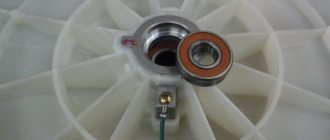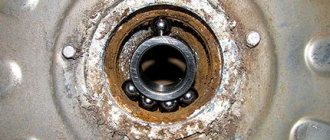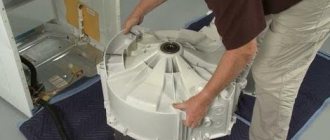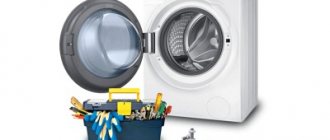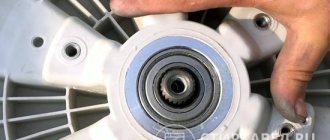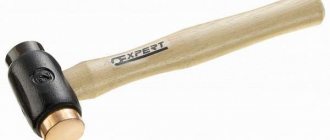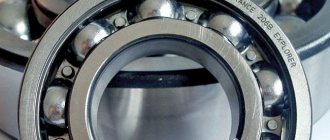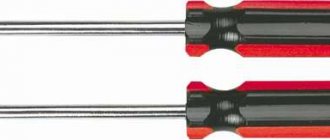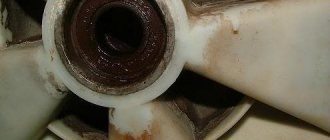Perhaps, any other type of repair work on a washing machine cannot be compared in complexity to replacing a bearing. This process is one of the most labor-intensive, since its successful completion requires complete disassembly of the washing machine.
If you have absolutely no idea how to change the bearing on an Indesit washing machine, and have never had experience in repairing household appliances, the work should be entrusted to the specialists from the service center. But don't jump to conclusions. Look at the replacement algorithm and maybe you will decide to carry out the repair yourself.
The need for timely repairs
Traditionally, horizontal loading washing machines use two bearings. These support elements hold the washing machine drum in place, keep it horizontal and rotate freely.
Both bearings are mounted on the same shaft and are sealed from water ingress by a seal on the inside of the drum. Meanwhile, wear of the existing seal after some time of operation of the device leads to water seeping into the area of the front bearing.
Replacing the support bearings of the working shaft of the washing machine is one of those serious malfunctions that requires time, a search for components, and the hands of professional performers to eliminate.
As a result, bearing parts corrode, rust and eventually fail. The drum does not rotate, loses balance, and jams. It’s better not to let it get to this point - you should change the bearings and carry out other repairs on the washing machine in a timely manner (when noise appears).
Indesit washing machines of the latest generations are equipped with a self-diagnosis system, which greatly facilitates and speeds up the identification of existing and impending breakdowns. Machine owners need to know error codes. Decoding them will help you understand whether you can repair it yourself or whether it’s better to go to a workshop.
Preparation
Before you begin any repairs, you need to make sure you have the necessary tools. You may need:
- a set of flat and Phillips screwdrivers;
- socket and open-end wrenches;
- set of heads and knobs;
- hammer;
- multimeter;
- bit;
- hacksaw for metal;
- pliers;
- WD-40 product;
- awl.
To disassemble a washing machine, you may need a variety of tools.
Please note that the presented list of tools and tools is as wide as possible and allows you to perform any repair. In some cases, you can get by with a much smaller set.
You must understand that troubleshooting can take more than one day, and the removed parts will take up a lot of space. Therefore, if possible, move the unit to a garage, shed or any other utility room, where it will not be in the way, and spare parts can be neatly laid out.
Before disassembling the automatic machine, find the warranty card and make sure that the warranty period has expired. Remember that the manufacturer is not responsible for equipment that was repaired at home, so if the warranty is still in force, contact a specialized service center.
If there is no free space, organize the work on site: prepare a section of the floor at least 2 x 2 m in size, removing carpets, furniture and covering it with film or old newspapers. Disconnect the washing machine from all communications and carefully disconnect the hoses.
It is imperative to drain the remaining water from the tank so that during disassembly it does not get on other parts. To do this, place a dry cloth under the machine, unscrew the drain filter and wait until all the water drains from the hole. Also remove the detergent tray (usually to do this you need to press the latch located in the middle and at the same time pull the part towards you) and set it and the filter aside.
In order to disassemble a washing machine, certain skills are required. If you are not confident in your own abilities, it is better to entrust the work to professionals.
So, the Indesit washing machine is ready for disassembly, what should you do first?
Bearing replacement procedure
Before starting repair work, it is strongly recommended to determine the exact nomenclature (labeling) of spare parts that make up the repair unit, find suppliers and buy everything that is needed for replacement.
A classic set of bearing units (No. 180202, 180203 or 180204), which is necessary for the repair of almost all models of washing machines under the Indesit brand that support a horizontal laundry loading configuration
As a rule, the set of purchased components is as follows:
- single row closed ball bearing (2 pcs.).
- rubber sealing cuff (1 pc.).
It is also recommended to obtain a service manual (repair instructions) for the Indesit specific model. The Internet and the official website of the brand will help here.
Finally, you need metalworking and electrical tools, in particular:
- screwdrivers are different;
- pliers, hex keys;
- set of open-end wrenches (socket wrenches);
- knife, hammer, files;
- puller for small bearings;
- sandpaper, wooden blocks, rags.
Armed with everything you need, having some repair experience and knowledge of electromechanics, you can safely begin setting up the washing machine.
Step 1. Access to the washing tub
The beginning of the repair process, of course, is to disconnect the washing machine from the power supply line. You will also have to disconnect the water supply and discharge hoses. It is advisable to disassemble the device in conditions of sufficient free space in the room.
Disassembling a horizontal-loading washing machine, where diagnostics showed a defect in the bearing assembly, usually begins with dismantling the top panel. Also on some models you need to open the rear hatch
It is recommended to prepare several trays for fasteners removed from different structural elements. Separate storage of the dismantled screws assigned to fasten each individual part will simplify the subsequent assembly of the machine.
The first fasteners that need to be removed are on the top panel of the washing machine. Typically you need to remove two to four mounting screws.
In parallel with the top panel, the dispenser for loading detergents, as well as the panel with control knobs, are dismantled. The dispenser bath is usually held in place by two or three plastic latches.
Before removal, the mechanical control panel must be disconnected via electrical contact groups. You should first draw up (draw) on paper and mark all the points of electrical connections of the control elements. Moreover, this must be done if there is no schematic diagram of the washing machine.
Dismantling the control panel along with the detergent dispenser module, as well as detaching the rubber cuff from the loading hatch body. On most models, the cuff is secured with a wire clamp
Step 2. Removing the tank (washing container)
The best option for dismantling the washing equipment tank is to remove this part through the opening that opens after removing the top panel of the machine body. Some models from Indesit have a removable cover on the back wall. This option is also suitable for recessing, but is considered somewhat inconvenient.
Removing the tank cover on a car that has a rear wall hatch. Here you don’t have to completely remove the tank if both halves of the tank are secured with a radial clamp. However, pulling out the cover with the drum through the hatch is quite problematic
In any case of dismantling the tank, you must first remove the coupling belt between the electric motor pulleys and the drum.
You will also need to disconnect the electric motor, which is usually attached to the tank body. Remove the clamp (or paper clips) that tightens the rubber cuff along the shell of the loading hatch and separate the cuff.
Then use a socket wrench to unscrew the drum pulley mounting screw and remove the pulley from the shaft using a puller. Next, you need to unscrew the counterweight fasteners (located on top of the drum) and remove this structural part.
Removing the counterweight installed on the top of the tank. This part is usually secured with three screws, two of which are removed with a socket wrench. Counterweight – a piece of concrete of a certain shape (there are different shapes depending on the model)
After all the noted manipulations, the washing machine tank remains hanging on the damper springs. Other models are equipped with additional lower shock absorbers. The springs are carefully unhooked, the shock absorbers are disconnected and the released tank is removed through the upper opening of the machine body (or through the opening in the rear area).
By the way, if the drum is removed through the opening in the rear wall of the washing machine body, it is not necessary to remove the entire tank structure. Why? More on this later.
Step 3. Proper disassembly of the washing machine tank
To get to the bearing assembly, you will need to separate the metal drum from the tank body, made of polyurethane. As a rule, the design of the tank of any washing machine, including the Indesit brand, consists of two halves. They need to be separated.
A tight connection of the body halves is achieved using a clamp or special metal clips. In the first case, it is enough to loosen the clamp to be able to disconnect and dismantle one half of the tank along with the drum.
Cutting the cast structure of a washing machine tank. These are increasingly found in the latest Indesit models. According to the manufacturer's idea, this type of tank cannot be repaired. But craftsmen refute engineering ideas
If the tie is made with paper clips, you will have to remove the entire tank, since it will not be possible to remove the paper clips from the sides without dismantling the tank. It should also be noted about the existing “soldered” version, where the two halves of the case are tightly sealed. Here, some craftsmen simply saw the tank body with a hacksaw along the solder line.
Step 4: Extracting Elements
So, the tank is removed and divided into halves, one of which holds the drum due to the bearing assembly. Now it's time to carefully remove the stuffing box and then separate (knock out) the drum shaft from the bearing assembly.
Removing the seal seal using a screwdriver. Not a very successful (incorrect) method of extraction, which usually destroys the part. However, in most repair options the seal still has to be replaced.
The stuffing box seal is removed using a screwdriver; you can also use a suitable puller. Next, half of the tank body with the drum is placed on wooden blocks (or other suitable supports) to provide a sagging state for the drum to separate it.
The drum should be separated (knocked out) very carefully. One of the options for the separation procedure is to make a metal pin-punch, which is screwed into the thread in place of the fastening bolt from the end of the shaft. Such a pin is wrapped tightly, after which the drum is knocked out with light blows of a hammer.
Removing the shaft and drum from the bearing assembly. The process is carried out by screwing (all the way) a metal pin 150-180 mm long into place of the mounting bolt, followed by lightly knocking it out with a hammer
Following the removal of the shaft with the drum, the process of dismantling the bearings is carried out. Typically, a bearing assembly contains two bearings of different sizes.
They are also knocked out using a tool that prevents damage to the seats. It is better, of course, to use a pulling puller, which, if desired, can be made from scrap materials.
Step 5. Replacing damaged unit bearings
Before installing bearings in the seating areas, thoroughly clean the mounting surfaces. It is not recommended to use aggressive cleaning agents. Cleaning plastic surfaces is done quite efficiently with a soap solution.
Particular attention must be paid to pressing (seating) bearings into place. The slightest distortion at the time of pressing threatens to result in deformation of the supporting walls. If this happens, you will have to replace the entire washing machine tank.
Pressing procedure for a new bearing. An ordinary wooden block made of strong wood, with a cross-section along the long side equal to the diameter of the bearing, is used as a pressing tool.
It is necessary to accurately place the bearing along the edges of the landing groove. Then, through a wooden block with a cross-section equal to the outer diameter of the bearing, slowly press the bearing into place evenly, with light blows of a hammer around the circumference. The same actions will be applied to the second copy.
After pressing in the supporting elements, you need to install a new oil seal on the bearing assembly on the inside of the tank body. Seating the oil seal also requires careful and attentive actions.
But in this way the oil seal ring is pressed into the groove of the drum body. Uniform distribution of impacts over the entire area of the sealing ring through a wooden block
Next, place the drum shaft on the bearings, but first the shaft must be cleaned with sandpaper and the surface lubricated with a thin layer of cyathim 221 or a similar product. All that remains is to connect the two halves of the tank and assemble the car.
Step 6. Reassembling the washing machine
The procedure for assembling the device is performed in reverse order. The assembled tank is placed inside the housing, hooked onto damper springs, attached to the lower shock absorbers, and connected to the loading hatch through a cuff.
Next, place a counterweight on the top of the tank, secure this part with bolts and move to the place where the motor is mounted. Having secured the electric motor to the body of the washing machine tank, put a pulley on the drum shaft, fasten it with a bolt and connect it with a transmission belt to the motor pulley.
Fastening the motor to the tank body and installing the torque transmission belt. Also, a harness of electrical conductors is usually attached to the housing, supplying power to the electric motor.
Next up is installing the control panel. This part of the structure is mounted with an eye to the previously made marks of electrical connections.
Then install the detergent dispenser housing and cover the washing machine body with the top panel. That's all, the replacement of the washing machine bearings has been successfully completed.
Upon completion of the assembly, the equipment is connected to working water hoses. Here, at the same time, it is recommended to remove the strainers (on the inlet valve and in the drain pump design), clean them or replace them with new ones.
Diagnosis of failure
Rumble and hum when the drum rotates in the washing mode, breakdown of the spin mode and rapid wear of the drive belt indicate a faulty bearings.
You can verify this by carefully inspecting the washing machine.
To do this, you need to open the door, grab the top of the drum with your fingers, try to swing it and determine whether there is play in the drum mount. And then spin the drum from the inside with your fingers, listen and try to catch extraneous noise.
If there is play, but there is no extraneous noise, this means that these parts have begun to deteriorate, but replacing them can be delayed for several months.
If there is play, and there are also characteristic noises (grinding, hum, rumble), but the drum rotates freely and does not stop, you need to change the bearings as soon as possible.
If the drum moves with a terrible grinding noise and even stops, it is generally dangerous to use this washing machine and requires urgent repairs.
The nuances of repairing models with vertical loading
Repair of the bearing assembly for Indesit structures for vertical loading is to some extent even easier than for horizontal devices. The configuration of the vertical loading tank of these washing machines is characterized by the fact that in order to replace the bearing (one!) and the seal seal, it is not necessary to disassemble the entire washing system.
It is enough to open the side panel on the side where the drum pulley is located and remove the pulley.
This is what the pulley of the Indesit equipment looks like, designed for vertical loading of laundry. It is attached to the shaft with a screw, the head of which has a groove for an asterisk key. Several hub mounting bolts are visible behind the pulley on the tank body.
This opens access to the hub, into the housing of which a bearing is pressed and an oil seal is installed. The hub is made of a removable part. It is attached with several bolts to the tank body. After unscrewing the screws, the hub can be easily removed.
The dismantled hub, inside of which the support bearing is visible. It can also be carefully knocked out and replaced with a new one. However, more often than not this is not done. Simply change the entire hub
Usually, if a drum bearing is damaged, it is not replaced separately, just like the oil seal.
Purchase the hub as a complete assembly kit (together with the installed bearing and oil seal) and replace this entire part. This approach seems more practical.
The following article will introduce you to all possible repair operations available to the independent owner of Indesit washing equipment, in which the breakdown options and methods for eliminating them are discussed in detail.
Initial disassembly stage
First, the casing is removed, covering all the insides of the equipment. To do this, you need to dismantle the rear hatch, which is attached with 6 screws. To unscrew them, you will need a medium-sized Phillips screwdriver.
It may be necessary to first spray the bottom screw with WD , because under the influence of dampness it will probably become rusty and completely rotted.
The next step is to remove the bottom strip , which covers the drain cover from the pump. Usually, the need to open it arises when the drain system becomes clogged with something or when replacing the pipe if the pump is intact.
Next, you will need to remove the powder and rinse aid tray. This can be done without any tools by lightly pressing it in an extended state on the edge. It is held on special slides-protrusions in the body of the filling device.
All housewives probably know how to do this, since quite often they need to be washed to remove mold. Further in the text we will look at how to remove the top cover of the Indesit washing machine and other parts in the correct order.
Removing the top cover
To remove the top cover, you will need to unscrew 2 screws using the same shaped screwdriver. They are located at the top of the back of the washing machine, directly underneath it. Then, standing in front, it must be moved. The designers have provided special grooves into which the lid is inserted and securely fixed even without additional fasteners.
Conclusions and useful video on the topic
You can learn how to repair a washing machine with a cast tank from the following video:
Concluding the topic of replacing bearings and hubs on Indesit brand washing machines, it should be noted: most models are made as disposable ones. That is, the equipment manufacturer, by default, developed these designs taking into account their zero maintainability.
Such equipment must be completely changed after the declared resource has been exhausted. However, as practice shows, virtually every model can be repaired.
Would you like to tell us how you restored the functionality of the Indesit washing machine with your own hands? Do you have information or technological nuances that are worth sharing with site visitors? Please write comments in the block form below, share useful information and photos on the topic of the article.
Set of tools
Surely you have a universal tool kit at home, which contains various types of screwdrivers with slotted and Phillips bits, screwdrivers, hexagon sets and pliers. You will also most likely need a hammer.
As for new parts that need to be replaced, you should not buy them in advance unless you know their exact markings. It would be much wiser to first remove them, and then select an appropriate replacement for them.
